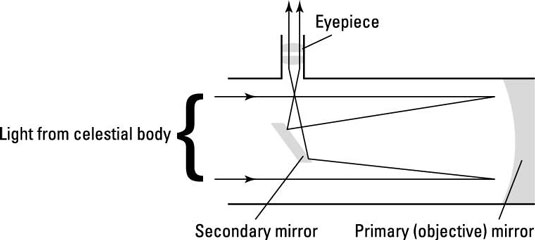When you’re ready to invest in a stargazing telescope, start by looking at the different models of telescope tube – the bits with the optics in. You can find quite a few different designs. Reflecting telescopes use mirrors to gather the light. Refracting telescopes use lenses. There are different kinds of reflectors, but in general the refractors all follow the same basic design.
Stargazing: Refracting telescopes
Refracting telescopes use lenses to collect and focus the light, just like binoculars do. In fact, you can think of a refracting telescope as one half of a giant pair of binoculars. The light enters a refracting telescope through the front lens, called the objective lens. It then travels down the length of the telescope to the eyepiece lenses, which is where the magnifying happens.

This setup can make observing through a refracting telescope quite uncomfortable, especially if you’re pointing your telescope high in the sky, because you may have to stoop and crane your neck to see through the eyepiece. Some telescopes come with a prism adaptor that bends the light through 90 degrees, so looking through the eyepiece is much more comfortable.
Refracting telescopes have several benefits over other telescopes:
Because the inside of the tube is sealed at both ends (with lenses), refracting telescopes don’t suffer from dirt inside.
Because the tube is sealed at both ends, refracting telescopes don’t have the problem of air moving about inside the tube, and so have sharper, steadier images.
However, refracting telescopes are longer and more unwieldy than reflecting telescopes, and can suffer from something called chromatic aberration, where a rainbow of colours appears around the image. Lens coatings and a longer telescope tube (which increases something called the focal length) can help reduce this problem.
Stargazing: Reflecting telescopes
One of the most common types of reflecting telescope is called a Newtonian reflector, named after the man who invented it, Isaac Newton (of falling apple fame). In Newtonian telescopes, the tube is open at one end.
The light enters the tube and reflects off a curved mirror (called the primary mirror) at the other end, before bouncing back up the tube to near the top where it reflects off a smaller mirror (called the secondary mirror), which bounces the light out of a hole in the side of the telescope where you attach your eyepiece.

This setup can make looking through the eyepiece a little tricky, especially in the bigger Newtonian telescopes, where you may need a step or small ladder to get high up enough to see through the eyepiece.
The benefits of Newtonian reflecting telescopes over other telescopes include the following:
Because the mirror can be fixed onto a metal plate, reflecting telescopes can be much bigger than refractors.
Reflecting telescopes are cheaper to make.
Reflecting telescopes don’t suffer from chromatic aberration.
A variation on the standard Newtonian telescope is the Cassegrain reflector, which uses a curved secondary mirror to bounce the light back down the length of the tube to an eyepiece at the bottom end.

Because of their design, Cassegrain reflectors can be more compact than their Newtonian cousins, because the light is ‘folded’ twice inside the tube, making two journeys rather than one. Cassegrain telescopes can be half the length of Newtonians. Cassegrain reflecting telescopes have all the same advantages as a Newtonian reflector, plus they’re much more compact
Another variation on the Newtonian reflector theme is the SchmidtCassegrain, in which a thin lens is placed over the front of the telescope tube. This lens gives the telescope a slightly wider field of view. To all intents and purposes, the design is the same as the standard Cassegrain.

